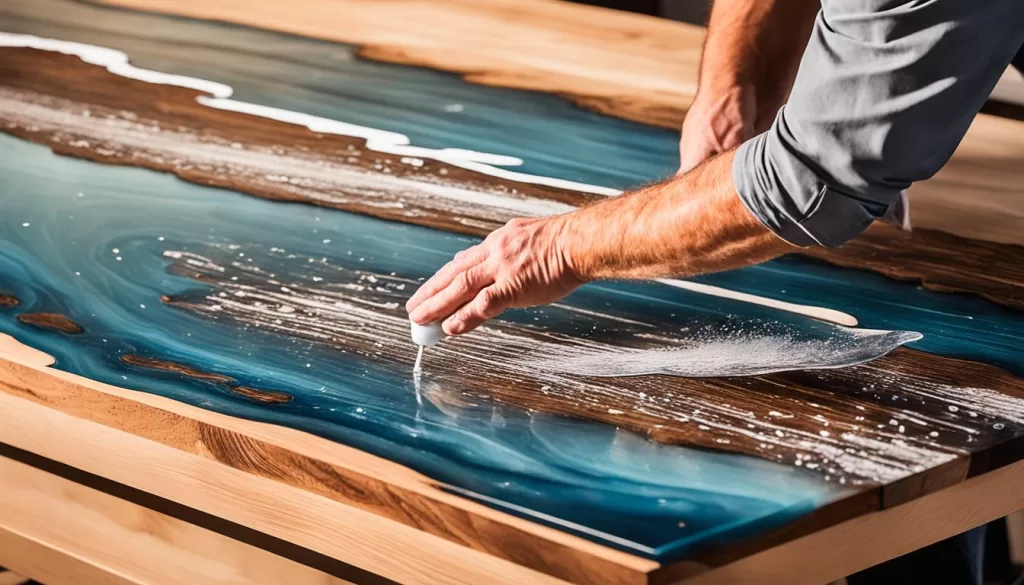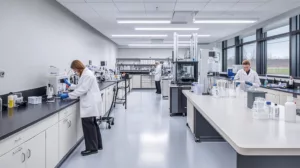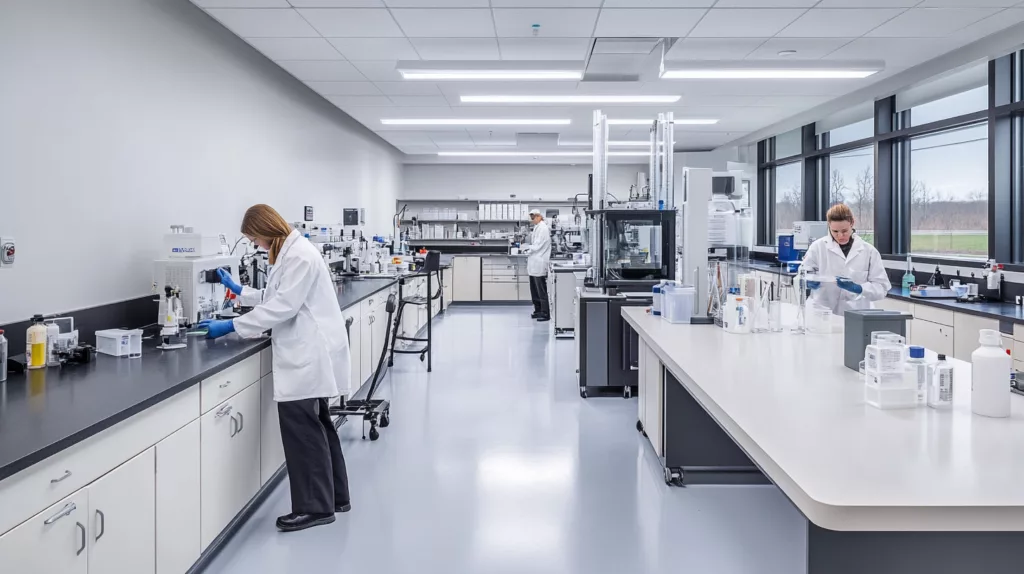Welcome to our guide on crafting river tables with crystal clear epoxy resin. Whether you’re a DIY enthusiast or a professional woodworker, we’re here to help you achieve stunning results. River tables have gained popularity for their unique and visually striking design, making them the perfect centerpiece for any room.
Using crystal clear epoxy resin, you can create a beautiful “river” or void in the center of the table that showcases the natural beauty of the wood. The translucent nature of the epoxy resin enhances the wood’s grain, resulting in a captivating piece of furniture.
In this article, we’ll take you through the step-by-step process of crafting river tables with crystal clear epoxy resin. From choosing the right epoxy resin to creating the river channel and applying a protective finish, we’ll cover all aspects to ensure your project’s success.
Key Takeaways:
- Crafting river tables involves using crystal clear epoxy resin to create a stunning “river” or void in the center of the table.
- The transparent nature of epoxy resin enhances the natural beauty of the wood grain.
- Key steps include selecting the right epoxy resin, carving the river channel, mixing and pouring epoxy resin, and applying a protective finish.
- Techniques such as adding pigments or objects can enhance the river effect.
- Sanding and polishing are crucial for achieving a professional-looking result.
What is a River Table?
Before diving into the crafting process, let’s first understand what a river table is. A river table is a unique piece of furniture that incorporates a “river” or void in the center, filled with clear epoxy resin. This design element creates a beautiful contrast between the natural wood slabs on either side of the river.
Whether you’re a DIY enthusiast or a seasoned woodworker, creating a river table can be a captivating and rewarding project. The combination of wood and epoxy resin offers endless possibilities for customizing and showcasing your creativity.
Using epoxy resin allows you to capture the organic beauty of the wood while adding a modern twist. The transparent resin creates a stunning effect, resembling a flowing river or an ethereal body of water embedded within the wooden structure.
By harnessing the power of epoxy resin, you can transform ordinary pieces of wood into extraordinary works of art.
When choosing the wood for your river table, consider options that enhance the natural appeal and complement the resin. Hardwoods like walnut, oak, or maple are popular choices due to their durability and striking grain patterns. However, feel free to explore other types of wood based on your personal preference and desired aesthetic.
Advantages of Using Epoxy Resin for River Tables:
- Provides a stable, durable, and long-lasting finish
- Captures the beauty of the wood grain
- Allows for customization with pigments, dyes, and embedded objects
- Creates a smooth and glass-like surface
- Protects the wood from moisture, stains, and scratches
Next, we’ll explore the different types of epoxy resin available and help you choose the best one for your river table project.
Choosing the Right Epoxy Resin
Selecting the right epoxy resin is crucial for achieving a crystal clear and durable finish for your river table. With numerous options available in the market, it’s essential to choose a high-quality epoxy resin specifically designed for river tables. We’ve done the research for you and compiled a list of the best epoxy resins that will help you create stunning river tables.
- Brand A Crystal Clear Epoxy Resin: This epoxy resin is known for its exceptional clarity and self-leveling properties. It provides a smooth finish and is resistant to yellowing, ensuring that your river table remains beautiful over time.
- Brand B River Table Epoxy: Designed specifically for river tables, this epoxy resin offers excellent flow and self-leveling characteristics. It creates a high-gloss finish and is UV resistant, preventing discoloration from sunlight exposure.
- Brand C Deep Pour Epoxy Resin: If you’re looking to create deep river channels, this epoxy resin is the ideal choice. It has a long working time and can be poured in thicker layers without generating excessive heat or air bubbles.
When selecting an epoxy resin, consider factors such as working time, cure time, UV resistance, and compatibility with different types of wood. Additionally, make sure to follow the manufacturer’s instructions and safety guidelines for proper handling and application.
Pro Tip: Before applying epoxy resin to your entire river table, it’s a good idea to do a small test pour on a scrap piece of wood. This will help you assess the clarity, self-leveling properties, and overall performance of the epoxy resin.
With the right epoxy resin, you can achieve a flawless and durable finish for your river table. Now that you know which ones to consider, let’s move on to the next step: selecting the perfect wood and preparing it for the epoxy resin application.
Wood Selection and Preparation
When it comes to crafting a river table, the choice of wood plays a vital role in determining the overall appearance and character of the final piece. Different wood species have unique grain patterns, colors, and textures that can complement or contrast the clear epoxy resin, creating stunning visual effects.
Before diving into the selection process, consider the aesthetic you want to achieve with your river table. Are you aiming for a rustic look with reclaimed wood or a more contemporary style with sleek hardwood? Understanding your desired outcome will help guide your wood selection.
When choosing wood for a DIY river table, keep in mind the following factors:
- Stability: Ensure that the wood is stable, with minimal warping or movement, to prevent cracks or gaps in the epoxy resin.
- Moisture Content: Use kiln-dried or properly seasoned wood to avoid issues with shrinkage or expansion after the epoxy resin is applied.
- Color and Grain: Select wood with interesting grain patterns and colors that will complement the river effect created by the epoxy resin. Woods like walnut, maple, and oak are commonly used for their beautiful natural characteristics.
- Size and Thickness: Consider the dimensions of your river table project and choose wood slabs that are wide enough to create a substantial river channel. Thicker slabs also provide a more dramatic effect.
Once you have chosen the perfect wood for your river table, it’s crucial to properly prepare it before applying the epoxy resin. Here are a few steps to follow:
- Sanding: Start by sanding the wood to remove any imperfections, rough spots, or splinters. Use progressively finer grit sandpaper for a smooth finish.
- Sealing: Apply a wood sealer or pre-epoxy coating to seal the wood pores and minimize air bubbles when the epoxy resin is poured.
- Masking: If you want to protect certain areas of the wood from the epoxy resin, such as natural edges or specific designs, use masking tape or painter’s tape to cover those areas.
By carefully selecting the right wood and properly preparing it, you can ensure that your river table project will result in a visually stunning and durable piece of furniture. Now that you are equipped with the knowledge of wood selection and preparation, let’s move on to the next step: creating the river channel.
Creating the River Channel
One of the most critical steps in crafting a river table is creating the river channel itself. This is where the epoxy resin will flow, creating the stunning river effect that gives these tables their unique charm. There are several techniques you can use to achieve a smooth and aesthetically pleasing river channel.
Carving the River Channel
If you have woodworking skills, carving the river channel can be a great option. This technique involves using chisels, gouges, or other carving tools to carefully remove the wood and create the desired shape. It allows for precise control over the curves and depth of the river, giving you the flexibility to create intricate designs.
Routing the River Channel
Another popular method is routing the river channel. This technique involves using a router with a straight bit or a custom-made template to remove the wood and create a clean, straight-edged channel. It’s a faster option compared to carving, but it may limit your design possibilities to straight or gentle curves.
Using Other Tools
Depending on your preferences and woodworking skills, you can explore other tools to create the river channel. For instance, you can use a combination of saws, files, and sanders to shape the channel. Each tool offers its own unique advantages and can help you achieve the desired results.
Remember, it’s crucial to plan and measure the river channel accurately before starting the carving or routing process. Take your time to visualize the final outcome and make precise cuts or passes to ensure a seamless fit for the epoxy resin.
Check out this visually engaging table showcasing the pros and cons of each technique:
| Technique | Pros | Cons |
|---|---|---|
| Carving | Allows for intricate designs | Requires more time and woodworking skills |
| Routing | Produces clean, straight edges | Limitations in design possibilities |
| Other Tools | Flexibility to use a combination of tools | May require more trial and error |
Experiment with different techniques and find the one that suits your style and vision for the river table. The river channel will serve as the centerpiece of your table, so take the time to perfect this step before moving on to the next stages of the crafting process.

Mixing and Pouring Epoxy Resin
Proper mixing and pouring of epoxy resin are essential for achieving a flawless finish on your river table. Follow our step-by-step instructions and techniques to ensure bubble-free and crystal clear results.
Mixing Epoxy Resin
To begin, gather the following materials:
- Epoxy resin (recommended: ZDS™ Crystal Clear Epoxy Resin)
- Hardener
- Measuring cups or scales
- Stirring Stick
- Pigments or dyes (optional)
Quote: “Accurate measurement of epoxy resin and hardener is crucial. Follow the manufacturer’s instructions and measure the ratio carefully to ensure proper curing.”
Here’s how to mix epoxy resin:
- Place the epoxy resin and hardener bottles on a clean and level surface.
- Wear disposable gloves and safety goggles for protection.
- Measure the required amount of epoxy resin and hardener according to the manufacturer’s guidelines.
- Pour the epoxy resin and hardener into a mixing container.
- Use a stirring stick to thoroughly mix the resin and hardener together for the recommended time, typically two to three minutes.
- If desired, add pigments or dyes to create custom colors. Stir gently until evenly dispersed.
Pouring Epoxy Resin into the River Channel
Now that your epoxy resin is properly mixed, it’s time to pour it into the river channel. Follow these steps:
- Ensure your river channel is clean, dry, and free from any debris.
- If necessary, use masking tape to protect the wood edges surrounding the river channel.
- Slowly pour the epoxy resin into the river channel, starting from one end and moving towards the other.
- Use a stirring stick to gently spread the epoxy evenly along the channel’s contours.
- If necessary, use a heat gun or torch to remove any surface bubbles.
Note: Always follow the manufacturer’s instructions for curing time and temperature. It’s crucial to allow the epoxy resin to fully cure before proceeding to the next steps.
With the epoxy resin mixed and poured, you’re one step closer to completing your stunning river table. In the next section, we’ll explore techniques for enhancing the river effect and adding unique touches to your table.
Enhancing the River Effect
To make your river table truly unique and visually captivating, there are several techniques you can utilize to enhance the river effect. By incorporating various elements and materials, you can elevate the beauty of your epoxy resin river table. Let’s explore these options:
- Pigments and Dyes: Adding pigments or dyes to the epoxy resin allows you to infuse vibrant colors into the river channel. Whether you prefer bold hues or subtle tones, this technique provides endless possibilities for customization. Experiment with different color combinations to achieve the desired aesthetic.
- Inserts: An innovative way to enhance the river effect is by inserting objects into the resin. You can strategically place stones, shells, or other small items that complement the overall design. This not only adds visual interest but also creates a unique story within your river table.
- Wood Staining: Implementing wood staining techniques on the surrounding slabs can create a striking contrast against the clear epoxy resin. Choose a stain color that harmonizes with the overall theme and enhances the natural beauty of the wood grain.
“Incorporating vibrant pigments or inserting organic materials can transform a river table into a mesmerizing art form that captures attention.”

Insert Techniques
| Insert Material | Effect |
|---|---|
| Stones or Pebbles | Adds a natural and organic feel |
| Shells or Sea Glass | Evokes a coastal or beach-inspired ambiance |
| Colorful Gems or Crystals | Creates a luxurious and glamorous look |
| Reclaimed Wood Fragments | Brings a touch of rustic charm |
Experiment with different materials and placement patterns to achieve the desired effect. Remember, the goal is to create a visually stunning river table that reflects your unique style and artistic vision.
Dealing with Imperfections
Sometimes, despite our best efforts, imperfections may appear during the epoxy resin curing process. But worry not! We’re here to help you address these issues and achieve a smooth and flawless finish for your river table.
Here are some tips and techniques to tackle common imperfections:
- Bubbles: Bubbles can occur when mixing and pouring epoxy resin. To prevent this, make sure to mix the epoxy thoroughly and avoid creating excessive turbulence during pouring. If bubbles do appear, you can use a heat gun or a propane torch to gently heat the surface and remove them. Remember to keep the heat source moving to avoid scorching the resin.
- Uneven Surface: If your river table has an uneven surface due to epoxy settling or uneven pouring, you can sand it down to achieve a smooth and level finish. Start with a coarser grit sandpaper and gradually move to finer grits for a polished look.
- Overflow: If epoxy resin overflows the river channel, don’t panic! You can trim off the excess resin using a router or a table saw once it has fully cured. Just be sure to take caution and wear safety gear while using power tools.
Remember, imperfections are a natural part of the crafting process, and they can even add character to your river table. Embrace the uniqueness of each piece and let your creativity shine!
Quick Tip: Preventing Imperfections
To minimize the occurrence of imperfections, here’s a helpful tip: create a seal coat layer before pouring the main epoxy resin. This seal coat helps to seal any small cracks or imperfections in the wood, reducing the chances of air bubbles or uneven surfaces.
By following these tips and techniques, you’ll be able to overcome imperfections and achieve a stunning river table that you’ll be proud to showcase in your space. Now, let’s move on to the next section and learn about sanding and polishing techniques to further enhance the beauty of your creation.
Sanding and Polishing
Sanding and polishing your river table is a critical step in achieving a professional-looking finish. This process not only smoothens the surface but also enhances the natural beauty of the wood and epoxy resin. We will guide you through the sanding process, using different grits and polishing compounds to bring out the best in your creation.
The Sanding Process
To begin the sanding process, you will need a variety of sandpaper grits. Start with a coarse grit, such as 80 or 100, to remove any imperfections or uneven areas on the surface. Sand in the direction of the wood grain to ensure smooth and even sanding. Gradually move to finer grits, such as 120, 180, and 220, to achieve a smoother finish.
After sanding with the finer grits, you can move on to wet sanding. Wet sanding with a high-grit sandpaper, like 400 or 600, will further refine the surface and remove any remaining imperfections. Remember to keep the surface wet while sanding to prevent the sandpaper from clogging and to ensure a smoother result.
Polishing for a Brilliant Shine
Once the sanding process is complete, it’s time to bring out the shine in your river table. Polishing compounds are used to achieve a glossy finish and enhance the depth of the epoxy river. Apply a small amount of polishing compound to a soft cloth or buffing pad and gently rub it onto the surface, using circular motions.
Continue buffing the surface until a brilliant shine appears. You may need to apply multiple layers of polishing compound, depending on the desired level of shine and the product’s recommendations. Take your time and work in small areas to ensure even coverage and a consistent finish.
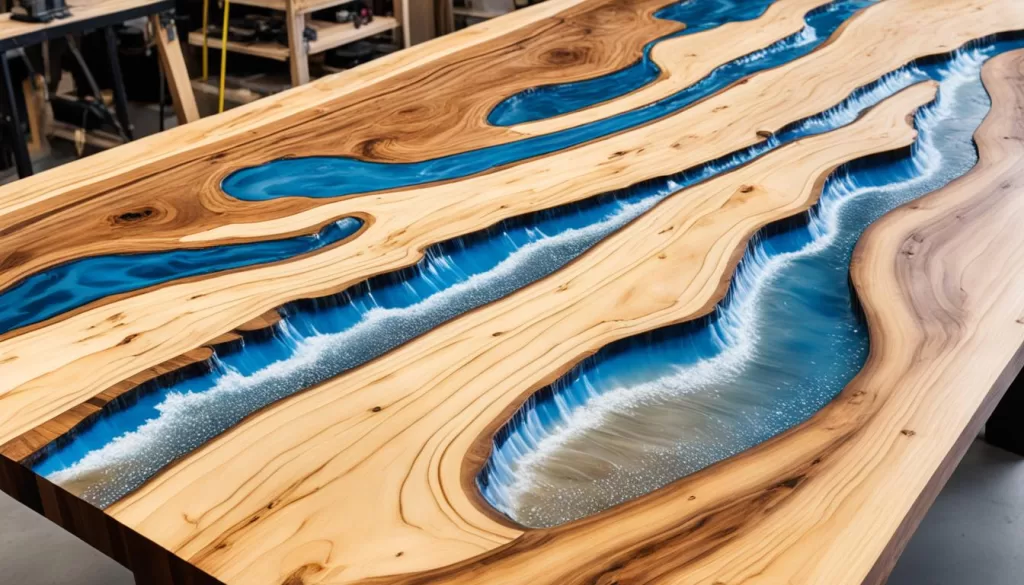
Pro Tip: If you’re working on a larger river table, consider using a power sander or a polishing machine to speed up the process. Just make sure to follow the manufacturer’s instructions and take proper safety precautions.
Once you’re satisfied with the level of polish, wipe off any excess compound with a clean, lint-free cloth. This will reveal the stunning beauty of your river table’s wood grain and epoxy river. Admire the smooth finish and the mesmerizing effect created by the crystal clear epoxy.
Applying a Protective Finish
Once your river table is sanded and polished, it’s important to apply a protective finish to prolong its lifespan and maintain its appearance. A protective finish not only enhances the beauty of your river table but also safeguards it against daily wear and tear.
There are various options for finishing your river table, and the choice depends on your personal preference and the level of durability you desire. Two popular choices for protective finishes are polyurethane and epoxy-based topcoats.
Polyurethane: Polyurethane is a versatile and durable finish that adds a glossy or satin sheen to your river table. It creates a protective layer that shields the wood and epoxy resin from moisture, spills, and scratches. Applying multiple coats of polyurethane can result in a more robust barrier and a smoother, glass-like finish.
Epoxy-based topcoats: Epoxy-based topcoats offer excellent durability and resistance to heat, chemicals, and UV rays. These topcoats are specifically formulated for use with epoxy resin and provide a high-gloss, crystal clear finish. They can enhance the depth and vibrancy of the river effect, making your table truly stand out.
Before applying any protective finish, ensure that your river table is free from dust and debris. Follow the manufacturer’s instructions for the specific product you choose, including application techniques, drying times, and recommended number of coats.
Remember to work in a well-ventilated area and use appropriate safety equipment, such as gloves and a respirator, when applying the protective finish. Allow the finish to cure fully before using or placing any objects on your river table.
By applying a protective finish, you can ensure that your river table remains beautiful and durable for years to come.
“Protective finishes not only enhance the beauty of your river table but also safeguard it against daily wear and tear.”
Tips and Tricks for Stunning Results
When it comes to crafting a river table with epoxy resin, attention to detail and a few clever tricks can make all the difference. In this section, we’ll share our top tips to help you achieve stunning results that will wow anyone who lays eyes on your creation.
Maintaining Control Over Epoxy Flow
Controlling the flow of epoxy resin is essential for achieving clean lines and a precise river channel. To keep the resin from spreading too far, try using damming techniques with materials such as foam, clay, or even painter’s tape. These barriers will guide the epoxy and ensure it stays within the desired boundaries.
Creating Unique Patterns
While the natural beauty of wood and crystal-clear epoxy resin already make a river table visually striking, you can take it a step further by incorporating unique patterns. Consider experimenting with different pouring techniques, such as layering different colored resins or creating swirls and waves, to add depth and a one-of-a-kind look to your table.
Enhancing Depth with Multi-layered Resin
To add depth to your river table design, try pouring epoxy resin in multiple layers. By applying resin in stages, you can achieve a three-dimensional effect that mimics the look of a flowing river. This technique allows you to create different depths within the river channel, enhancing the overall visual appeal of your table.
Sealing Wood Before Pouring
Before pouring epoxy resin, it’s crucial to seal the wood to prevent any air bubbles or moisture from complicating the curing process. Apply a sealant or wood conditioner to all wood surfaces, including the river channel, and allow it to dry fully. This proactive step will help ensure a smooth and successful epoxy pour.
Adding Inlays and Decorative Elements
To make your river table truly unique, consider adding inlays or decorative elements to the design. This could involve embedding small objects like stones, shells, or even LED lights into the epoxy resin. These creative touches will add character and personalization to your piece.
Proper Ventilation and Working Conditions
Epoxy resin can emit strong odors and should always be used in a well-ventilated area. Additionally, maintaining the correct temperature and humidity levels can greatly impact the resin’s curing process. Be sure to work in a clean and controlled environment to minimize any potential issues and ensure the best results for your river table.
| Tips and Tricks | Description |
|---|---|
| Maintain control over epoxy flow | Use damming techniques to guide epoxy resin within desired boundaries. |
| Create unique patterns | Experiment with different pouring techniques and colors for a one-of-a-kind look. |
| Enhance depth with multi-layered resin | Pour epoxy resin in multiple layers to create a three-dimensional effect. |
| Seal wood before pouring | Apply a sealant or wood conditioner to prevent air bubbles and moisture. |
| Add inlays and decorative elements | Embed small objects or LED lights into the epoxy resin for added character. |
| Ensure proper ventilation and working conditions | Work in a well-ventilated area with appropriate temperature and humidity levels. |
By implementing these tips and tricks, you’ll be well on your way to creating a stunning river table that showcases your craftsmanship and creativity. Remember to have fun along the way and let your imagination flow!
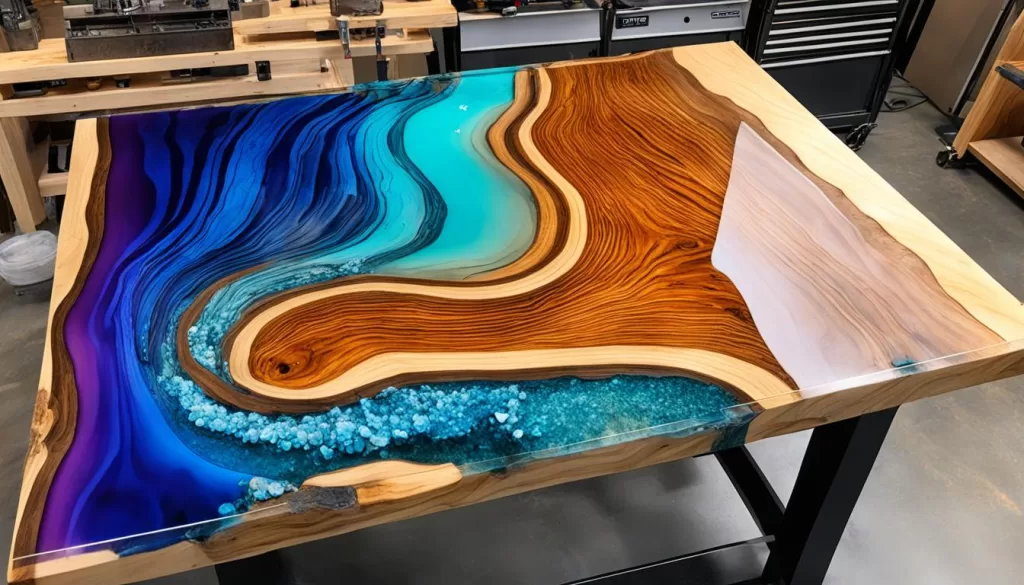
Conclusion
Crafting river tables with crystal clear epoxy resin is a truly rewarding and creative process. By following our techniques and tips, you can transform plain wood slabs into stunning pieces of furniture that will be the highlight of any space.
Throughout this article, we’ve guided you through every step of the process, from understanding what a river table is to choosing the right epoxy resin, selecting the perfect wood, creating the river channel, and mixing and pouring the epoxy resin. We’ve also explored ways to enhance the river effect, deal with imperfections, sand and polish your table, and apply a protective finish.
Now, armed with this knowledge, you can embark on your own river table journey and let your creativity flow. Whether you’re a DIY enthusiast or a seasoned woodworker, the possibilities are endless. So roll up your sleeves, gather your materials, and get ready to create a breathtaking piece of furniture that showcases the beauty of nature and the artistry of epoxy resin.
FAQ
What is a River Table?
A river table is a unique piece of furniture that incorporates a “river” or void in the center, filled with clear epoxy resin. This design element creates a beautiful contrast between the natural wood slabs on either side of the river.
How do I choose the right epoxy resin for my river table?
Choosing the right epoxy resin is crucial for achieving a crystal clear and durable finish. We recommend selecting epoxy resins specifically designed for river tables, as they have excellent clarity and UV resistance.
What type of wood should I use for my river table?
The type of wood you choose for your river table can greatly impact its overall appearance. It’s best to use wood with a relatively straight grain, such as walnut, maple, or oak, to ensure a smooth and even river channel. Additionally, make sure the wood is properly dried and free from any defects or moisture.
How do I create the river channel in my river table?
Carving or routing a river channel can be done using various techniques. You can use a combination of hand tools, such as chisels or gouges, or power tools like a router or CNC machine. Take your time and work slowly to achieve the desired shape and depth.
What is the process for mixing and pouring epoxy resin?
Mixing epoxy resin requires precise measurements and thorough blending. Follow the manufacturer’s instructions regarding the resin and hardener ratio, as it can vary depending on the brand. Once mixed, pour the epoxy resin into the river channel, using a slow and steady motion to minimize the formation of bubbles.
How can I enhance the river effect of my table?
There are several techniques you can use to enhance the river effect in your table. You can add pigments or dyes to the epoxy resin to create different colors or gradients. You can also embed objects like stones, shells, or even LED lights to create a captivating visual effect.
What should I do if imperfections appear in the epoxy resin?
If imperfections appear during the epoxy resin curing process, you can address them by sanding the affected area and reapplying a thin layer of epoxy resin. Sanding will remove any blemishes or unevenness, allowing you to achieve a smooth and flawless finish.
How do I sand and polish my river table?
Sanding and polishing your river table is essential to achieve a professional-looking result. Start by using a low grit sandpaper to remove any roughness or irregularities. Gradually progress to higher grits for a smooth and polished surface. Finally, use a polishing compound to bring out the natural beauty of the wood and epoxy resin.
What kind of protective finish should I apply to my river table?
Applying a protective finish is crucial to prolong the lifespan and maintain the appearance of your river table. You can choose from various options, such as polyurethane or epoxy-based topcoats. These finishes provide durability, UV protection, and enhance the visual appeal of your table.
What are some tips and tricks for achieving stunning results with a river table?
To achieve stunning results with your river table, consider the following tips and tricks:
– Control the epoxy resin flow to create unique patterns and designs.
– Experiment with different pigments and dyes to achieve the desired colors.
– Use a heat gun or torch to remove any bubbles that may appear during the curing process.
– Take your time and work patiently to ensure a high-quality finish.
– Seek inspiration from other river table projects and explore your creativity.
Is crafting river tables with epoxy resin a difficult process?
While crafting river tables with epoxy resin requires some skill and patience, it is an achievable project for both DIY enthusiasts and professional woodworkers. By following proper techniques and recommendations, you can create a stunning piece of furniture that will be the highlight of any space.


